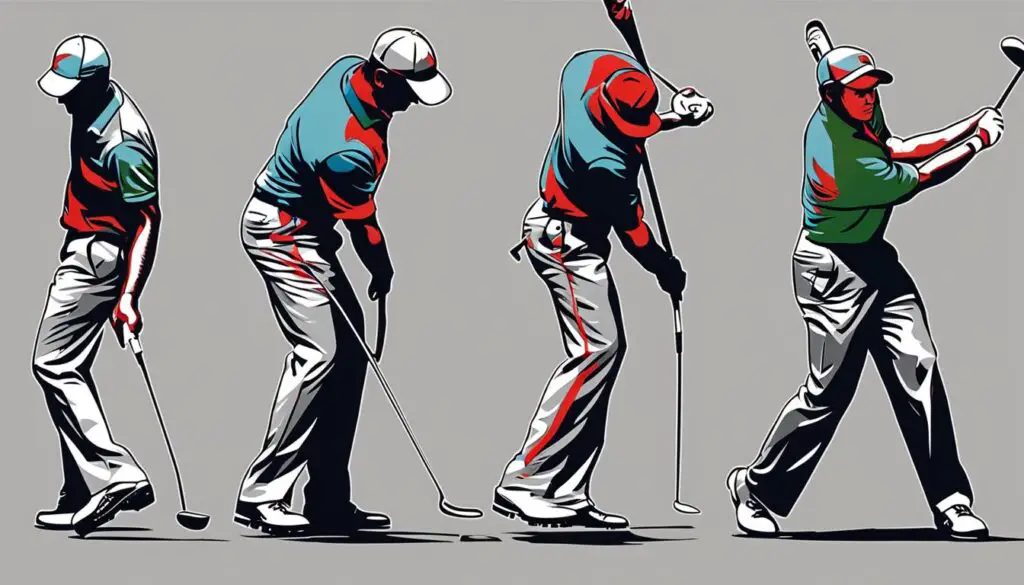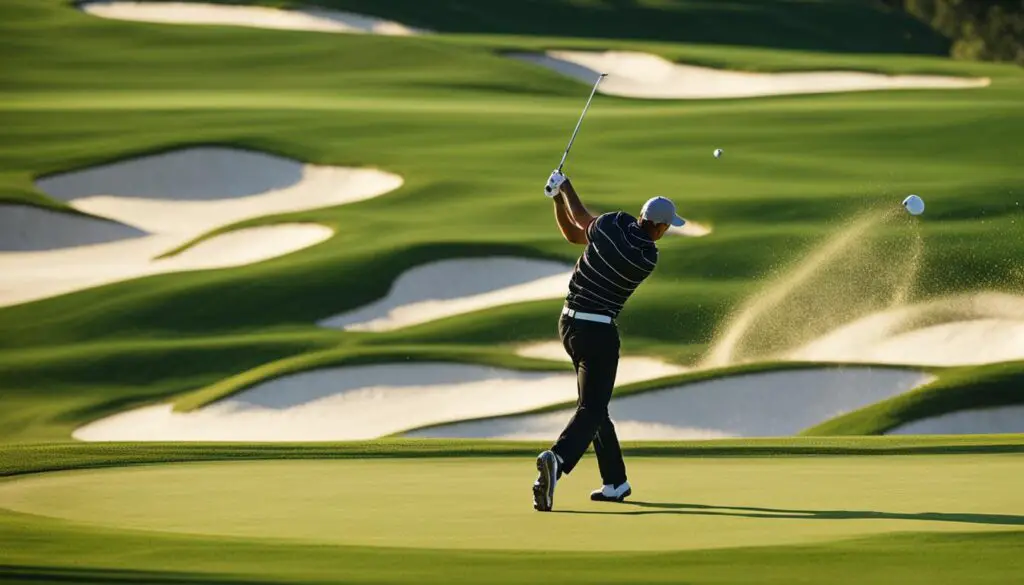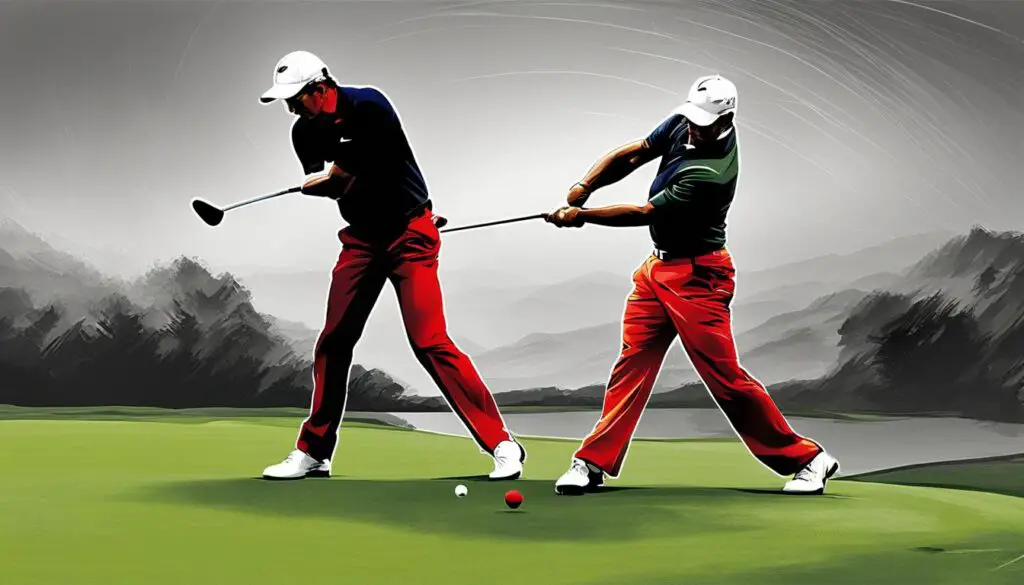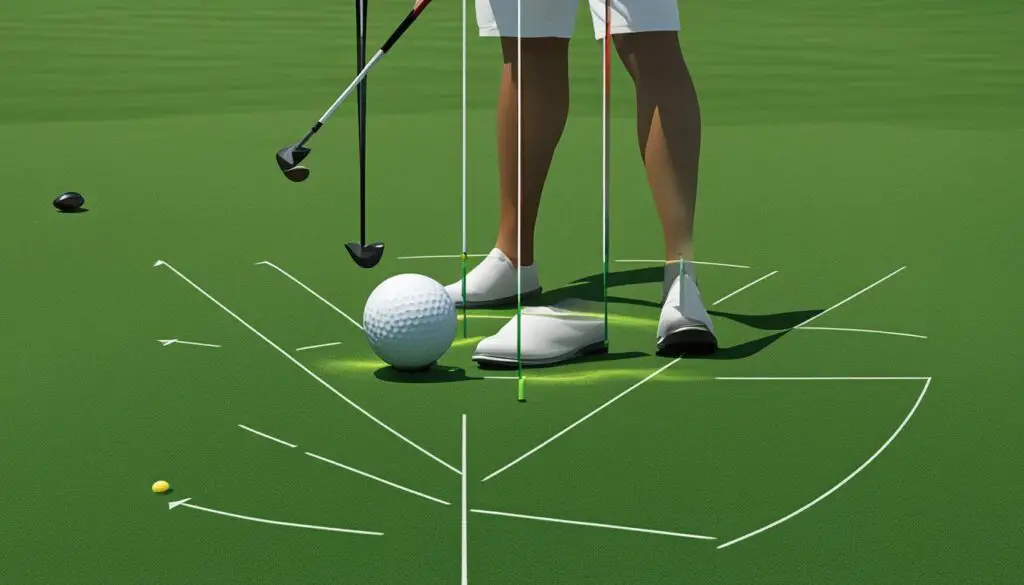Are you looking to take your golf game to the next level? A great place to start is by honing your golf swing mechanics. By understanding the proper techniques and implementing effective golf swing tips, you can improve your swing and become a better golfer.
Whether you’re a beginner or a seasoned player, perfecting your golf swing is crucial for consistent and accurate shots. In this article, we will delve into the key elements of a successful swing, from grip and body movement to timing and impact position. By mastering these aspects, you’ll be well on your way to becoming a pro on the green.
So, grab your clubs and get ready to enhance your game. Let’s dive into the world of golf swing mechanics and discover how you can improve your swing, effortlessly.
Key Takeaways:
- Understanding and implementing proper golf swing techniques can significantly improve your game.
- The lead-hand grip plays a crucial role in preventing hooks and ensuring stability and control of the club-face.
- Body movement, sequencing, and timing are vital for generating power and preventing mis-hits.
- Posture, alignment, and ball position contribute to consistent and accurate strikes.
- Mastering the backswing, transition, and downswing is key to achieving a smooth and powerful swing.
The Importance of the Lead-Hand Grip
When it comes to improving your golf swing, one aspect that cannot be overlooked is the lead-hand grip. Golf legends such as Jack Nicklaus and Ben Hogan have emphasized the crucial role of the grip in preventing the dreaded hook. To achieve stability and control of the club-face, they recommend a grip that places the club in the fingers and the palm of the lead hand. By adopting this grip, you can reduce the chances of hooking the ball and gain better control over your shots.
By focusing on the lead-hand grip, you can eliminate the left side of the course and ensure that your shots stay on target. This grip allows for a more neutral club-face position at impact, preventing excessive hand rotation and promoting a straighter ball flight. It also helps in maintaining a consistent grip pressure, ensuring that you have a firm hold on the club without gripping it too tightly.
When it comes to hook prevention, mastering the lead-hand grip is a fundamental step. As you make this grip a part of your swing mechanics, you’ll find that your shots become more accurate and reliable. So remember, the next time you head out to the golf course, pay attention to your lead-hand grip and experience the difference it can make in your game.
The Benefits of the Lead-Hand Grip:
- Prevents the hook by promoting a neutral club-face position.
- Provides stability and control over the club.
- Reduces excessive hand rotation for a straighter ball flight.
- Helps maintain consistent grip pressure.
- Improves shot accuracy and reliability.
Understanding Body Movement to Avoid Hooks
When it comes to improving your golf swing and minimizing hooks, understanding and mastering your body movement is crucial. By focusing on your body’s position and movement throughout the swing, you can achieve a more consistent and accurate shot. Here are some key tips to help you prevent hooks and maintain an on-balance finish:
- Balance is key: Maintaining balance throughout your swing is essential to prevent hooks. Focus on evenly distributing your weight and keeping your body centered over the ball. This will help you avoid excessive lateral movement and promote a more controlled swing.
- Lead-side dominance: To avoid hooks, it’s important to shift your weight and get into your lead-side on the downswing. This allows for proper rotation and a more on-plane swing. By initiating the downswing with your hips and maintaining a strong lead-side position, you can prevent the club from getting stuck behind your body, reducing the chances of hooks.
- Relaxed posture: Tension in your body can negatively impact your swing and increase the likelihood of hooks. It’s important to maintain a relaxed posture throughout the swing, with a slight bend in your knees and a relaxed grip on the club. This will help you achieve a smoother and more fluid swing motion.
By incorporating these body movement tips into your golf swing, you can improve your overall accuracy and minimize hooks. Remember to practice these techniques consistently to develop muscle memory and achieve a more consistent swing.

Summary:
Understanding how your body moves during the golf swing is crucial for preventing hooks. By focusing on maintaining balance, shifting your weight to the lead-side, and keeping a relaxed posture, you can improve your swing mechanics and achieve an on-balance finish. Practice these body movement techniques to enhance your swing and minimize hooks in your game.
Unlocking Power with Proper Sequence of Motion
When it comes to improving your golf swing and maximizing your driving distance, understanding the proper sequence of motion is key. By syncing up your movements and delivering speed into the ball at the right time, you can unlock more power in your swing.
One important aspect of the sequence of motion is the transition from the backswing to the downswing. This transition should be smooth and progressive, allowing your club head to pick up speed as it comes into contact with the ball. By initiating the downswing with a hip and shoulder movement sequence, while keeping your arms relaxed and allowing them to fall naturally, you can generate maximum club head speed and achieve powerful drives.
Another crucial element of the sequence of motion is the dynamic position of your body throughout the swing. As you transition from the backswing to the downswing, focus on maintaining an athletic posture and shifting your weight effectively. This will help you transfer energy from your body to the club, resulting in more powerful and accurate shots.
So, if you’re looking to increase your driving distance and improve your overall swing, pay attention to the proper sequence of motion. By syncing up your movements, generating speed at the right moment, and maintaining a dynamic body position, you can unleash the full power of your golf swing.
Key Points:
- Sync up your movements and deliver speed into the ball at the right time.
- Ensure a smooth and progressive transition from the backswing to the downswing.
- Maintain an athletic posture and shift your weight effectively for optimal energy transfer.
- Focus on generating maximum club head speed for powerful drives.
The Role of Hips in Maintaining Club Path
The movement of your hips in the golf swing has a significant impact on the club’s path and the trajectory of the ball. Proper hip movement is essential for achieving a consistent and accurate swing. When your hips rotate correctly, it allows for a more efficient transfer of power from your body to the club, resulting in better ball striking and increased distance.
One key aspect to focus on is turning the belt buckle into the lead thigh during your downswing. This movement helps to initiate the rotation of your hips and creates a solid foundation for the rest of your swing. By maintaining this connection between your belt buckle and lead thigh, you can ensure that your hips are properly engaged throughout the swing, promoting a straighter club path.
It’s important to note that over-rotating or trying too hard to clear the hips can lead to an open club face at impact and result in errant shots. Finding the right balance in your hip rotation is crucial for maintaining control of the club and producing consistent ball flight. Practice drills and exercises that focus on hip mobility and stability can help you develop the proper hip movement and improve the overall effectiveness of your swing.
The Role of Hips in the Golf Swing:
- Proper hip movement maintains club path and ball trajectory
- Turn your belt buckle into the lead thigh during the downswing
- Over-rotation can lead to an open club face and errant shots
- Practice drills for hip mobility and stability

“The movement of your hips in the golf swing has a significant impact on the club’s path and the trajectory of the ball.”
Calibrating Impact Position for Consistent Strikes
When it comes to achieving consistent and powerful strikes in your golf swing, calibrating your impact position is key. By understanding the proper alignment and ensuring that the club strikes the ball at the optimal point with a square face, you can maximize your power potential and improve your overall performance on the course.
One important aspect to consider is the club path. The path of the club during impact greatly affects the direction and trajectory of the ball. By focusing on a correct club path, you can achieve more accurate and controlled shots. This involves having a clear understanding of the desired swing plane and making adjustments if necessary. By aligning the club path properly, you can consistently strike the ball in a way that produces the desired flight and direction.
“Calibrating your impact position is crucial for achieving consistent and powerful strikes in golf.”
In addition to club path, the position of your body at impact also plays a significant role. Your body position should be balanced and stable, allowing for a solid strike. This involves maintaining the proper posture and spine angle throughout your swing, as well as a controlled rotation of your hips and shoulders. By calibrating your impact position, you can ensure that your body is in the optimal position to transfer power and generate maximum club head speed.
Summary:
- Calibrating your impact position is crucial for consistent and powerful strikes.
- Focus on the club path to achieve more accurate and controlled shots.
- Maintain proper body position for a balanced and stable strike.
Golf Swing Energy Transfer: Timing for Powerful Ball Contact
When it comes to maximizing power in your golf swing, one key factor to consider is the timing of energy transfer. Proper timing allows for a seamless transfer of energy from your body to the club, resulting in powerful ball contact. By focusing on timing, you can unlock the potential for effortless power in your swing.
Timing is critical in ensuring that your swing reaches its peak efficiency at impact. It requires a harmonious coordination of various elements, including your body movements and the speed of your club. When everything aligns correctly, you can generate maximum clubhead speed and deliver a forceful strike to the ball.
One way to improve timing is through dedicated practice drills that specifically target energy transfer. These drills help you develop a sense of timing and sync up the movements of your body and club. By honing your timing skills, you can achieve a fluid swing motion that allows for an efficient transfer of energy, resulting in powerful and accurate shots.

Remember, achieving proper timing for energy transfer is not about swinging harder or using excessive force. It’s about finding the right rhythm and synchronizing your movements to create a smooth and efficient swing. So, invest time in practicing your timing and feel the difference it can make in the power and consistency of your golf swing.
Proper Posture for a Solid Golf Swing
Having the correct posture is crucial for achieving a solid golf swing. It not only sets the foundation for a consistent and powerful swing but also helps improve your balance and overall performance on the course. To ensure you have the right posture, follow these essential tips:
- Adopt an athletic position: To establish a solid foundation, stand with your feet shoulder-width apart and slightly bent knees. This athletic position allows for better stability and weight transfer throughout your swing.
- Hinge forward at the hips: Maintain a slight forward bend at the hips, which promotes a better spine angle and alignment with the ball. This position helps optimize your clubhead’s interaction with the ball.
- Relax your arms: Keep your arms relaxed and allow them to hang naturally from your shoulders. Tension in the arms can restrict your swing and affect clubhead speed and accuracy.
- Maintain balance: Focus on distributing your weight evenly between your feet. Avoid leaning too far forward or backward, as this can throw off your balance and compromise your swing.
By practicing and ingraining these posture principles into your game, you can enhance your swing mechanics, leading to more consistent and powerful shots on the golf course.
“Having proper posture in golf is like building a strong foundation for a house. Without it, everything else becomes more challenging.”
Good posture leads to a better swing
Athletic position, balance, and foundation are key components of a proper golf swing. When you establish the correct posture, you create a stable platform that allows for optimal weight transfer, club control, and swing movement. It enables you to generate power from the ground up and maintain consistent contact with the ball.
Additionally, proper posture helps prevent injuries and strain on your body. By aligning your body correctly, you reduce the risk of back pain, muscle tension, and other common golf-related injuries.
So, remember to start your swing with a solid foundation by maintaining the correct posture. It may take practice and conscious effort at first, but over time, it will become second nature and significantly improve your golf game.
Achieving Perfect Body Alignment
When it comes to improving your golf swing, achieving perfect body alignment is essential. Proper alignment ensures that your shots start where you intend them to, leading to greater aim accuracy and more consistent results. To achieve this, it’s important to align your feet, shoulders, and hips to the target line.
One helpful tip for aligning your feet is to imagine there is a railroad track beneath you, with the target line as the outside rail. Position your feet parallel to the inside rail, pointing slightly left of the target for right-handed golfers. This will help you align your body properly and improve your aim.
Remember to also align your shoulders and hips to the target line. Rotate your chest and shoulders so they are parallel to the target line, while keeping your hips in line with your feet. This proper alignment will help you maintain a consistent swing path and prevent misdirected shots.
Alignment Cues to Improve Your Aim
- Use alignment aids, such as clubs or alignment sticks, to visually guide you towards the target line.
- Visualize a straight line from your ball to the target and align your body accordingly.
- Take practice swings with proper alignment to develop muscle memory and reinforce good habits.
Proper body alignment is the foundation for accurate shots in golf. By adopting the correct posture and using alignment cues, you can improve your aim and hit more accurate shots.
By paying attention to your body alignment, you can enhance your aim accuracy and improve your overall golf game. Experiment with different alignment techniques and find a method that works best for you. Consistent alignment will give you the confidence to take your shots with accuracy and precision.
The Impact of Ball Position on Swing
Properly positioning the golf ball in your stance is crucial for achieving optimal swing mechanics and launch conditions. The location of the ball should vary depending on the club you’re using, as different clubs require different ball positions to ensure solid contact and desired ball flight. By understanding the impact of ball position on your swing, club selection, and launch conditions, you can enhance your overall performance on the course.
When using the driver, it’s recommended to position the ball just inside your left heel (for right-handed golfers). This forward ball position helps promote a sweeping motion, maximizing distance off the tee. Conversely, when using wedges and short irons, the ball should be positioned in the center of your stance or slightly back from center. This allows for more consistent ball contact and better control over trajectory and spin.
It’s important to note that ball position is not the only factor that affects launch conditions. Factors such as swing speed, angle of attack, and clubface angle at impact also play significant roles. Experimenting with different ball positions and monitoring the resulting ball flight can help you determine the optimal position for each club in your bag. Additionally, receiving guidance from a professional golf instructor can provide valuable insights tailored to your individual swing.
The Impact of Ball Position on Swing: Key Takeaways
- Vary the ball position in your stance based on the club being used.
- Position the ball forward in your stance for drivers to promote a sweeping motion and maximize distance.
- Place the ball in the center or slightly back for wedges and short irons to ensure consistent contact and control over trajectory and spin.
- Remember that ball position is just one factor affecting launch conditions, along with swing speed, angle of attack, and clubface angle at impact.
- Experiment with different ball positions and consult with a golf instructor to fine-tune your swing and optimize performance.

The Backswing as the Foundation of the Swing
The backswing is a crucial element of the golf swing, setting the foundation for the rest of the motion. It is during this phase that the club is taken away from the ball, preparing for the downswing and impact. A smooth and well-executed backswing is essential for achieving a consistent and powerful golf swing.
One of the key aspects of a successful backswing is a smooth takeaway. This involves starting the club back with a controlled and fluid motion, avoiding any jerky or abrupt movements. By maintaining a smooth takeaway, you set the stage for a more coordinated and consistent swing.
Another important factor in the backswing is maintaining width in your arms. This means keeping your lead arm (the left arm for right-handed golfers) extended and resisting the temptation to collapse it. By maintaining this width, you create a larger arc and more room for power in the swing.
Lastly, achieving a full shoulder turn in the backswing is crucial for generating power and setting the proper club path. Allowing your shoulders to rotate fully away from the target helps create torque and coil in the body, ready to be unleashed during the downswing. A full shoulder turn also promotes a more on-plane swing, leading to a more consistent ball strike.
Remember, the backswing is the groundwork for a successful golf swing. Focus on a smooth takeaway, maintain width in your arms, and achieve a full shoulder turn to set yourself up for a powerful and accurate swing.
Mastering the Transition for Rhythm and Control
The transition from the backswing to the downswing is a critical moment in the golf swing. It is during this phase that you have the opportunity to create rhythm, maintain control, and set yourself up for a powerful and accurate ball contact. The key to mastering the transition lies in perfecting your timing.
Timing is crucial in every aspect of the golf swing, and the transition is no exception. Taking your time at the top of the backswing allows you to initiate the downswing smoothly and seamlessly. Rushing this moment can lead to a loss of control and a lack of power. By pausing briefly at the top, you give yourself the chance to gather your thoughts and ensure that your body and club are in sync.
“The transition is where you start to gather yourself and generate the rhythm and speed necessary for a powerful and controlled downswing.” – Golf Pro
To achieve a smooth transition, it’s important to focus on the sequence of your movements. Start the downswing by initiating a hip and shoulder movement sequence. Allow your arms to fall naturally and follow the lead of your lower body. This coordinated motion will help generate speed and clear your left side, setting the stage for a powerful release of energy into the ball at impact.
- Take your time at the top of the backswing to gather yourself.
- Focus on the sequence of your movements, starting with the hip and shoulder rotation.
- Allow your arms to fall naturally and follow the lead of your lower body.
- Clear your left side for a powerful release of energy at impact.

Perfecting Your Timing
Timing is the glue that holds your entire swing together. Without proper timing, your swing can feel disjointed, and your shots may lack consistency. To perfect your timing, focus on developing a smooth and balanced rhythm throughout your swing.
One way to work on your timing is to practice with a metronome. Set the metronome to a rhythm that feels comfortable for you, and then try to match your swing tempo to the beats. This exercise can help you develop a consistent rhythm and ensure that all the moving parts of your swing are working together harmoniously.
Remember, timing is not just about speed. It’s about finding the right balance and synchronizing your body and club movements. By mastering the transition and perfecting your timing, you can develop a more effortless and controlled golf swing.
Achieving a Smooth Downswing and Impact
The downswing is a crucial phase in the golf swing where you generate power and deliver a solid strike. It is essential to execute a smooth downswing to maintain control and maximize club head speed, leading to a powerful impact with the ball. To achieve this, focus on the following key factors:
1. Initiate the downswing with a hip and shoulder movement sequence: Begin the downswing by rotating your hips and shoulders in sync, allowing your arms to fall naturally. This sequence of movement creates a smooth transition and sets the stage for generating speed and power.
2. Clear your left side for impact: As you initiate the downswing, ensure that your hips and shoulders rotate fully, allowing your left side (for right-handed golfers) to clear out of the way. This enables you to unleash your club head speed and make solid contact with the ball.
3. Maintain a consistent swing tempo: Timing is crucial in the downswing. Aim to maintain a steady rhythm throughout, avoiding any rushed or jerky movements. Consistency in tempo promotes a smooth and controlled downswing, translating into more consistent and powerful strikes.
Summary:
In summary, the downswing is where the magic happens in your golf swing. By initiating the downswing with a proper hip and shoulder movement sequence, clearing your left side for impact, and maintaining a steady tempo, you can achieve a smooth downswing and maximize club head speed. Mastering this phase of the swing will lead to powerful and accurate ball contact, taking your game to the next level.

The Importance of Timing for Effortless Power
When it comes to achieving effortless power in your golf swing, timing is everything. It’s not just about how hard you swing, but also about when you swing. Good timing allows you to maximize your club speed and generate more power without exerting unnecessary effort.
Rhythm is a key component of timing in your golf swing. It’s about finding that smooth flow in your motion, from the backswing to the downswing and through to impact. By establishing a balanced swing with a consistent rhythm, you can optimize the transfer of energy from your body to the club, resulting in explosive shots down the fairway.
Club speed is directly influenced by your timing. When your swing is perfectly timed, the club speed increases naturally, enabling you to achieve greater distance and control. This is why professional golfers seem to effortlessly launch the ball with incredible speed and accuracy.
So, how can you improve your timing? Practice is key. By dedicating time to refining your swing and focusing on the rhythm of your motion, you can gradually develop a better sense of timing. Consistency is key, so stay committed to your training and watch as your golf swing becomes more powerful and effortless.
FAQ
How can I prevent hooking the ball?
One technique recommended by golf legends like Jack Nicklaus and Ben Hogan is to have a lead-hand grip that allows for stability and control of the club-face. By placing the grip in the fingers and palm of the lead hand, you can gain better control and eliminate the left-side of the course.
What should I focus on to avoid hitting hooks?
To avoid hitting hooks, it’s important to focus on your body movement throughout the swing. Maintaining a balanced finish by getting into your lead-side on the downswing can help prevent hooks. Additionally, avoiding the advice of “let the club do the work” and maintaining a relaxed posture can contribute to a more controlled and accurate swing.
How can I increase my driving distance?
One of the keys to improving driving distance is focusing on the sequence of motion. By syncing up your downswing and effectively delivering speed into the ball, you can increase your driving distance. Proper sequencing can improve your contact and the dynamic position of your body, resulting in more powerful and accurate shots.
How does the movement of my hips affect the club’s path?
The movement of your hips in the golf swing greatly affects the club’s path and the trajectory of the ball. When a golfer tries too hard to clear the hips, it can lead to an open club face and line-drive tee shots. By focusing on turning the belt buckle into the lead thigh, you can improve your swing and prevent mis-hits.
How can I achieve consistent, center-face strikes?
A key factor in achieving consistent, center-face strikes is understanding how your club should track into impact. By calibrating your impact position and ensuring that the club strikes the ball at the proper point with a square face, you can maximize your power potential. This will allow you to harness your speed at the right moment and achieve consistent, center-face strikes.
How can I transfer energy efficiently in my swing?
The transfer of energy from your body to the club is essential for generating effortless power in your swing. Timing this transfer correctly can result in a slower body motion through impact, allowing the energy to shoot out to the club and ultimately into the ball. By practicing drills that focus on transferring energy efficiently, you can tap into more power in your swing.
What is the importance of good posture in a golf swing?
Good posture is a fundamental aspect of a solid golf swing. By adopting an athletic position with a slight forward hinge at the hips, bent knees, and relaxed arms, you can establish a foundation for a consistent swing. Maintaining proper posture throughout your swing is crucial for delivering a solid strike to the ball.
How can I improve my aim and hit more accurate shots?
Precise alignment is essential for accurately hitting your target in golf. Establishing proper body alignment by aligning your feet, shoulders, and hips to the target line helps ensure that your shots start where you intend them to. By using alignment cues and checking your positioning, you can improve your aim and hit more accurate shots.
How does ball position affect my swing?
The position of the golf ball varies depending on the club being used. By adjusting the ball position, you can achieve optimal impact position and launch conditions for each club. From a forward position with the driver to a middle position with wedges, understanding ball position can lead to better ball flight and more consistent strikes.
What should I focus on during the backswing?
The backswing sets the foundation for a successful swing and impacts the rest of your motion. By focusing on a smooth takeaway, maintaining width in your arms, and achieving a full shoulder turn, you can ensure a solid backswing. This will help with sequencing and timing, resulting in better overall swing mechanics.
How can I achieve a smooth transition from the backswing to the downswing?
The transition from the backswing to the downswing is a critical moment in the golf swing. Taking your time at the top of the backswing and maintaining a smooth rhythm allows for better control of the swing. This transition should initiate a progressive increase in club head speed, leading to powerful and accurate ball contact.
What should I focus on during the downswing?
A smooth downswing is essential for maintaining control and maximizing club head speed. By initiating the downswing with a hip and shoulder movement sequence, while allowing the arms to fall naturally, you can generate speed and clear your left side for impact. This will result in a powerful release of energy into the ball at impact.
How can I achieve effortless power in my swing?
Timing plays a crucial role in achieving effortless power in your golf swing. Developing good timing through a harmonious sequence of motion and a balanced swing allows for optimal transfer of energy and club speed. By focusing on timing, you can tap into your power potential and consistently hit powerful shots.
